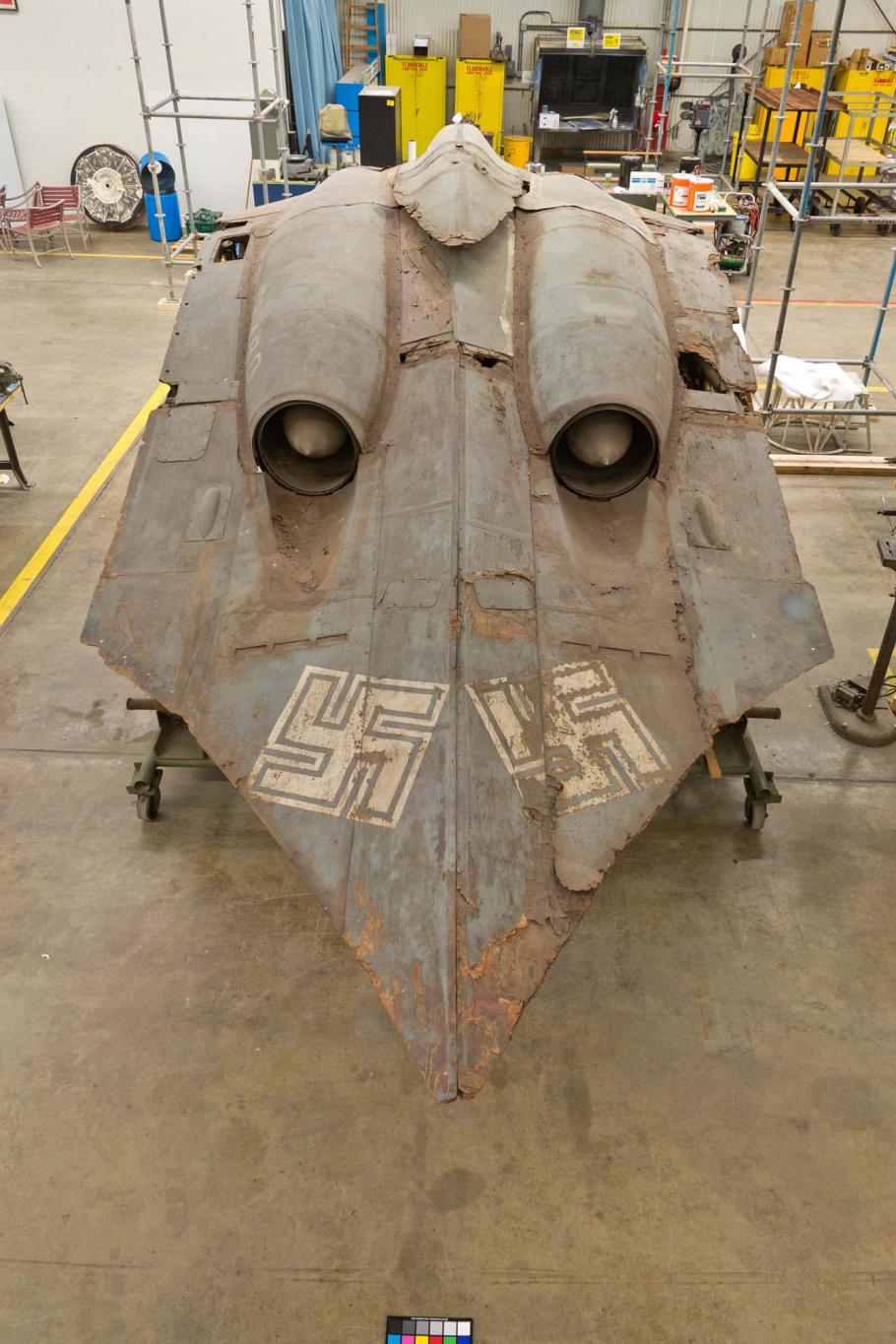Prior to the Horten Ho 229 V3 becoming a museum artifact, it was a prototype model under construction at the Gothaer Waggonfabrif workshop in Friedrichroda, Germany. After it was acquired in Germany, it was transported to England and then to Chicago where it was assembled for display by the United States Army. In 1952, it was transferred to the Smithsonian's National Air Museum (now the National Air and Space Museum). Some of the damage evident on the jet today occurred during these various moves.
In 1952, the National Air Museum was in its infancy with only a small number of buildings assigned to house its growing collection. The Horten jet wing was placed in a wooden enclosure and stored outdoors from 1952 until 1974. The majority of its present condition issues include extensive plywood veneer delamination, material loss, biological growth, and coating delamination. In addition to deterioration of the wooden outer skin, metal components are corroded, fasteners have failed, and numerous small parts are missing.
The Horten Ho 229 V3 from the aft. Comparing this newer image of the Horten Ho 229 V3 with historical photographs help conservators determine which coatings were added at a later date. Based on historical photographs, the blue/grey paint and swastikas were added at a later date and were not original to the aircraft.
Image: Ben Sullivan, 2013
The effects of fluctuating temperature, relative humidity, and exposure to rain while in the wooden enclosure produced biological growth that deteriorated some of the wood used to form the plywood. Fluctuations in relative humidity led to expansion and contraction of some wooden components, producing delaminated areas and detached wooden parts like those illustrated in the image below. The 'belly' panel below was particularly badly deteriorated due to accumulation of rainwater on the wooden surface.
This image shows the proper right large belly panel of the Horten Ho 229 V3 prior to conservation treatment.
Microscopic examination of the wood showed exactly what form of biological deterioration had taken root and was responsible for transforming the plywood into a powdery and fragile material. The image below was taken of a sample of Horten plywood examined with a scanning electron microscope and reveals the extensive presence of a particular type of fungus. The identification of this fungus was useful in determining what treatment steps we should take to discourage further growth and remove the branched structures of the fungus growth where possible.
Prior to the Horten Ho 229 V3 becoming a museum artifact, it was a prototype model under construction at the Gothaer Waggonfabrif workshop in Friedrichroda, Germany. After it was acquired in Germany, it was transported to England and then to Chicago where it was assembled for display by the United States Army. In 1952, it was transferred to the Smithsonian's National Air Museum (now the National Air and Space Museum). Some of the damage evident on the jet today occurred during these various moves.
In 1952, the National Air Museum was in its infancy with only a small number of buildings assigned to house its growing collection. The Horten jet wing was placed in a wooden enclosure and stored outdoors from 1952 until 1974. The majority of its present condition issues include extensive plywood veneer delamination, material loss, biological growth, and coating delamination. In addition to deterioration of the wooden outer skin, metal components are corroded, fasteners have failed, and numerous small parts are missing.
The Horten Ho 229 V3 from the aft. Comparing this newer image of the Horten Ho 229 V3 with historical photographs help conservators determine which coatings were added at a later date. Based on historical photographs, the blue/grey paint and swastikas were added at a later date and were not original to the aircraft.
Image: Ben Sullivan, 2013
The effects of fluctuating temperature, relative humidity, and exposure to rain while in the wooden enclosure produced biological growth that deteriorated some of the wood used to form the plywood. Fluctuations in relative humidity led to expansion and contraction of some wooden components, producing delaminated areas and detached wooden parts like those illustrated in the image below. The 'belly' panel below was particularly badly deteriorated due to accumulation of rainwater on the wooden surface.
This image shows the proper right large belly panel of the Horten Ho 229 V3 prior to conservation treatment.
Microscopic examination of the wood showed exactly what form of biological deterioration had taken root and was responsible for transforming the plywood into a powdery and fragile material. The image below was taken of a sample of Horten plywood examined with a scanning electron microscope and reveals the extensive presence of a particular type of fungus. The identification of this fungus was useful in determining what treatment steps we should take to discourage further growth and remove the branched structures of the fungus growth where possible.

